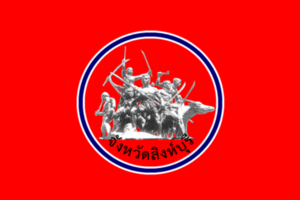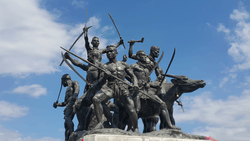Bang Rachan
The village of Bang Rachan (Thai: บางระจัน, pronounced [bāːŋ rā.t͡ɕān]) was north of Ayutthaya, the old capital of Siam, the predecessor state to modern Thailand. Today it is in Khai Bang Rachan District of Sing Buri Province. The village is remembered in Thai popular history for its resistance against the Burmese invaders in the Burmese–Siamese War (1765–1767) that ended the Ayutthaya Kingdom.

According to Thai tradition, the Burmese northern invasion army led by General Ne Myo Thihapate was held up for five months at Bang Rachan by villagers there.[1] The popular narrative cannot all be true as the entire northern campaign took just over five months (mid-August 1765 to late-January 1766), and the northern Burmese army was still stuck in Phitsanulok, in north-central Siam, as late as December 1765. Burmese sources mention "petty chiefs" (cf. "mueang") stalling the northern Burmese army's advance, but it was early in the campaign along the Wang River in northern Siam (not near Ayutthaya) during the rainy season (August–October 1765). The Burmese general who was then present near Ayutthaya was not Thihapate, but rather Maha Nawrahta, whose southern army was waiting for the northern Burmese army to show up to attack the Siamese capital.[2] It appears that the three verified events: petty chiefs resisting Thihapate in the north, Thihapate's campaign period of five months, and Maha Nawrahta dawdling near Ayutthaya—have merged to create this Siamese mythology.
The Thai narrative is now an ingrained part of Thai popular culture. The 2000 Thai film Bang Rajan dramatizes the Thai version of events.
One of the more iconic images is that of Nai Thong Min, who becomes drunk and furiously rides a gigantic water buffalo into battle against the Burmese. The public memory of the battle has been likened to that of the Battle of the Alamo in the minds of Americans.[3]
Historical revisionism

In 1767, Burmese armies entered Siam. Burmese accounts describe the invasion as having a deliberate and predetermined ambition, credited to King Mang Ra. Other sources and analysts of the period, most notably Damrong Rajanubhab, the father of Thai history, consider this to be historical revisionism and believe that the Burmese did not initially invade with the intention of permanent conquest nor with any designs on Ayutthaya itself.[4]
Burmese forces encountered little resistance from the Siamese and advanced close to the capital, but hesitated to attack due to their uncertainty regarding the strength of the forces to be faced. There was much raiding of the surrounding countryside and, contrary to the general policy which required the submission of the Siamese, they demanded the unmarried daughters of the local populace as well, a policy which provoked the Siamese people to resistance.
The beginning of the resistance and the first notable accounts of Bang Rachan occurred when a group of Siamese villagers from various villages—notably Sibuathong, Pho Krap, and Pho Thale—led by Nai Thaen, Nai Chote, Nai Inn, Nai Muang, Nai Thong Kauo, and Nai Dok Mai lured a group of Burmese soldiers into the forest with the promise of rescuing the women who were held captive and then turned upon the soldiers, killing the entire group of twenty. After this they retreated to Bang Rachan, where most of the population of the villages of Mueang Wiset Chaichan, Mueang Sing, and Mueang San had fled.
Bang Rachan is described as being ideally suited to defense: "A place where foodstuffs were plentiful...a village on high ground and ... difficult for the enemy to get at." In addition to its ideal situation and its swelling numbers, Bang Rachan had at this point approximately 400 fighting men. They had 11 leaders (Nai Thong Min, Nai Panreuang, Nai Thong Saeng Yai, Nai Chan Nuad Keao, Nai Thaen, Nai Chote, Nai Inn, Nai Muang, Nai Thong Kauo, Nai Dok Mai and Nai Khun Sun) and had worked on making fortifications. A Buddhist priest, Thammachot, had been invited into the village monastery where he was held in great veneration by the villagers. They believed him to have great powers and knowledge of spells, charms, and incantations.
The Burmese leaders camped at Mueang Wiset Chaichan, were aware of the slaughter of their men by the Siamese who had fled to Bang Rachan and sent a small force of about 100 men to capture them. The Burmese were taken by surprise when they were attacked while resting and were almost entirely wiped out by the force led by Nai Thaen, who had been elected leader of Bang Rachan.
News of this victory spread quickly across the country and resulted in more people coming out of hiding to join the resistance movement, swelling the ranks camped within Bang Rachan to 1,000 fighting men. This amateur force was organized along the lines of a professional military unit, but were disadvantaged by their lack of equipment, especially firearms.
Aware that he was facing heavy resistance, the Burmese leader at Wiset Chaichan requested reinforcements before sending another force against the village. But again he underestimated the village's resolve, as a second, 500-strong Burmese attacking force was routed. A third attack, again greater in numbers and under a new leader, was similarly defeated.
A pivotal event occurred during the fourth attack on the village by a force of 1,000 Burmese under Surin Chokhong. This force was not immediately defeated by the Siamese villagers, but their commander was killed and after much fighting the villagers retreated. Instead of seizing their advantage, the Burmese force lowered its guard to begin preparing food and caring for the corpse of their commander. Seeing this, the villagers quickly returned to the field and the surprised Burmese force was defeated and lost most of its troops. While victorious again, the leader of Bang Rachan, Nai Thaen, was shot in the knee, an event which would have grave consequences for the resistance.
The aftermath of this fourth battle saw both sides receive reinforcements, with the leaders selecting a new leader out of the eleven to replace Nai Thaen, who had become Nai Chan Nuad Keao, who was famed for his ferocity and "bristling moustache". The fortunes of Bang Rachan remained positive under Nai Chan Nuad Keao, who the forces increase and achieve ever greater levels of organization. Bang Rachan's reputation grew to such an extent that the Burmese came to fear them and the leaders had trouble recruiting troops to attack the village.
After seven attacks and seven defeats, an eighth force, under a Mon commander who had lived in Siam, volunteered to take an army and defeat Bang Rachan. What set this commander apart from the previous Burmese leadership was his knowledge of the land and the Siamese and his lack of arrogance. He did not underestimate the villagers. He adjusted his tactics to disadvantage them. He inched slowly towards the village, building a series of forts along the route and, when faced with the villagers, refused to fight except from within fortress walls.
A lack of artillery was now crippling the villagers, as they could not reduce the Burmese forts without it. They suffered great losses from infantry assaults. One of the Siamese leaders, Nai Thong Min, got drunk and, furious, mounted a water buffalo, to attack the Burmese with a small force in what remains one of the iconic images of Bang Rachan. He was killed and his men routed, the first defeat of the villagers by the Burmese.
Bang Rachan pleaded for help from Ayutthaya. They asked for cannons they could deploy against the forts, but the Ayutthaya showed the indifference typical of its actions throughout the war. They refused the request. One man, Phraya Rattanathibet, was sent to help villagers forge their own weapons. The guns they cast cracked and were useless. Soon after this, Nai Then died of the wound to his knee and the other leaders, Nai Chan Nuad Keao and Nai Khun San, had succumbed to their wounds they had sustained when trying to take down the Burmese forts.
4 out of the 11 leaders had died and now the village was by now dispirited and hopeless, and faced a siege by the Burmese in the form of cannon fire, siege towers, and tunneling under village walls. Saldly, the village was routed despite its resistance to the very end, five months after its first act of resistance. It was the only successful opposition by Siamese forces in a war characterized by the failure of Ayutthaya, its professional armies, and its generals.
A battle monument is 13 kilometers southwest of the town on Route 3032 in Khai Bang Rachan District.
Bang Rachan in film
Two Thai films about Bang Rachan have been made. One was in 1966 and it starred Sombat Metanee. Better known is the 2000 film by director Thanit Jitnukul and starring Winai Kraibutr. Oliver Stone adopted the film and "presented" screenings of it in the United States in 2004.
See also
- Ayutthaya Kingdom
- Siam
- History of Thailand
- History of Burma
Notes
- Wyatt, p. 117
- Phayre, pp. 188-189
- Duncan Stearn (18–24 July 2003). "Thai 'Alamo': Defence of Bang Rajan, 1766". Pattaya Mail. XI (29). Pattaya: Pattaya Mail Publishing Co. Retrieved 27 August 2013.
The story of Bang Rajan has become to the Thais what the siege of the Alamo (1836) is to Texans and, by extension, the United States: a symbol of determination and heroism against overwhelming odds.
- Chutintaranond, Sunait (1992). "The Image of the Burmese Enemy in Thai Perceptions and Historical Writings" (PDF). Journal of the Siam Society. Siam Heritage Trust. JSS Vol. 80.1.1l (Digital): image 2. Retrieved August 24, 2013.
The Burmese sack of Ayudhya in the second half of the eighteenth century was dramatically different from the attack in 1569. Prince Damrong in his Our Wars with the Burmese states that "the expedition led by the king of Hamsavati (Bayinnaung) and the one carried out by the king of Ava (Hsinbyushin) are not the same ... the primary purpose of the former in attacking Ayudhya was to reduce the Thai to vassalage and to expand his kingdom in the manner of a king of kings (Ratchathirat or Rajadhiraja), while the major aim of the latter was just to loot the city and take away war prisoners. Thus, in the last attack, the Burmese, with no intention of retaining Ayudhya as their client state, burnt all big and small cities they captured, including the capital, down to ashes.
References
- Rajanubhab, Prince Damrong. Our Wars with the Burmese: Thai-Burmese Conflict 1539-1767, ISBN 974-7534-58-4
- Kyaw Thet (1962). History of Union of Burma (in Burmese). Yangon: Yangon University Press.
- Phayre, Lt. Gen. Sir Arthur P. (1883). History of Burma (1967 ed.). London: Susil Gupta.
- Wyatt, David K. (2003). History of Thailand (2 ed.). Yale University Press. ISBN 978-0-300-08475-7.